fall inside a hole
Plarail "New Power" Gearbox
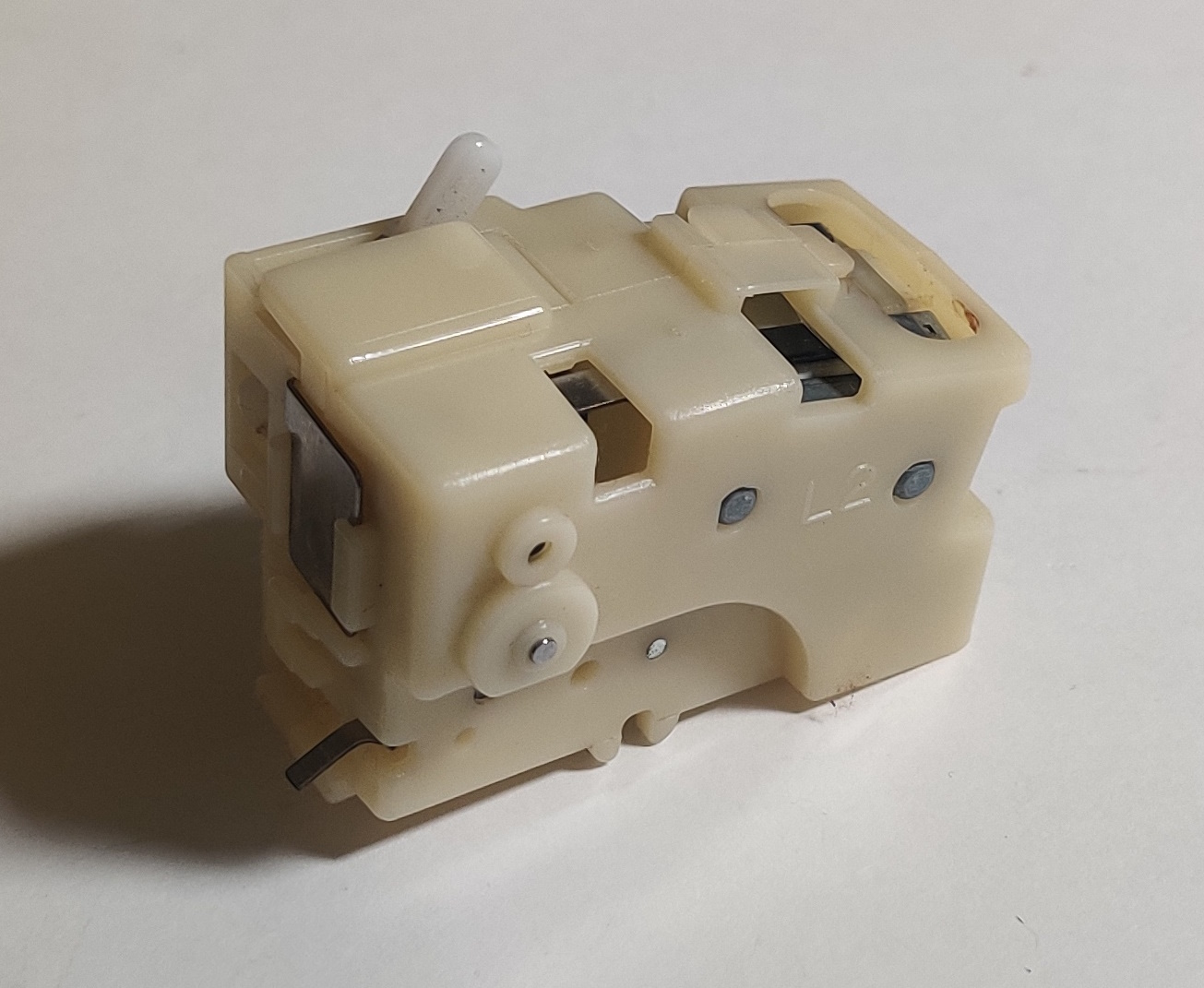
The so-called "new power" gearbox was introduced in 1987 and ushered in a new era of tractive power for Plarail toys. The new power gearbox transmitted power directly to the axle of the driven wheels instead of the friction-drive system used by the old power gearboxes and was made in both single and two-speed variants. Over time I have found many examples of both of these styles of gearbox to be breaking down, almost always because the plastic gears inside have contracted and split on the metal axles, leaving them spinning in place or meshing very roughly.
This gearbox is contained within two molded plastic pieces. Most versions of this gearbox have molding markings on each half that refer to them as L for left and R for right. Sometimes these letters are also accompanied by a number or text referring to the gearbox being two speed.
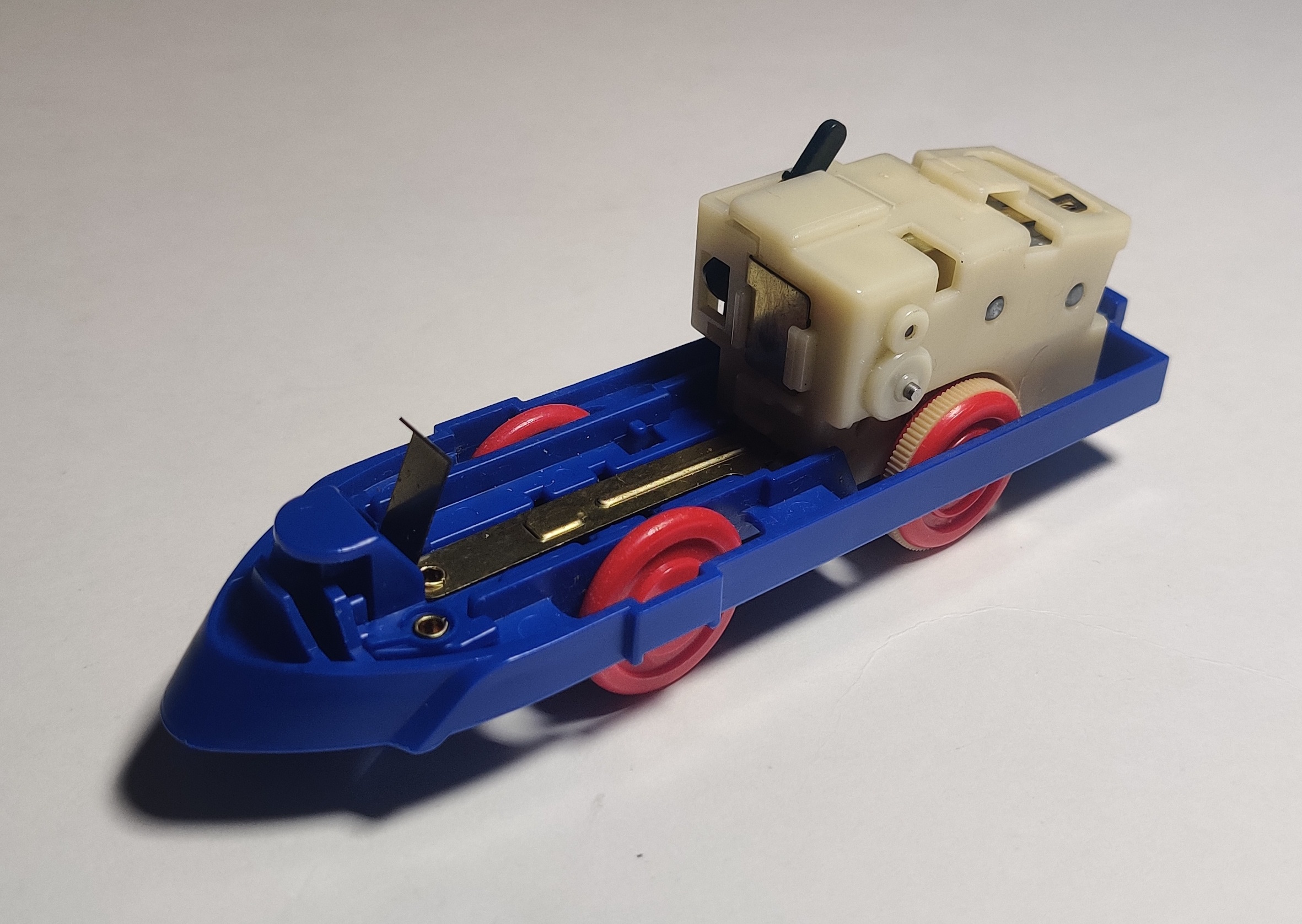
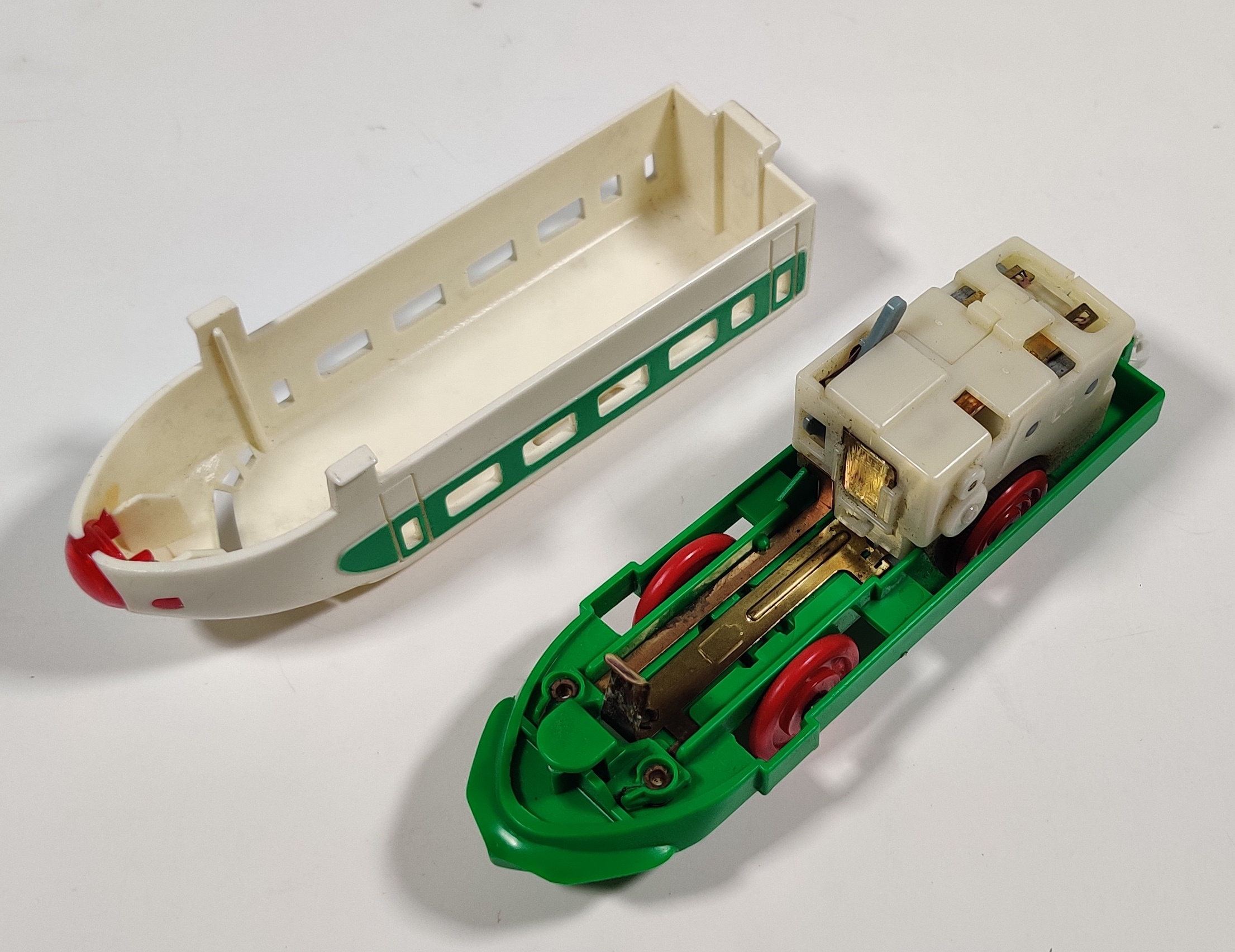
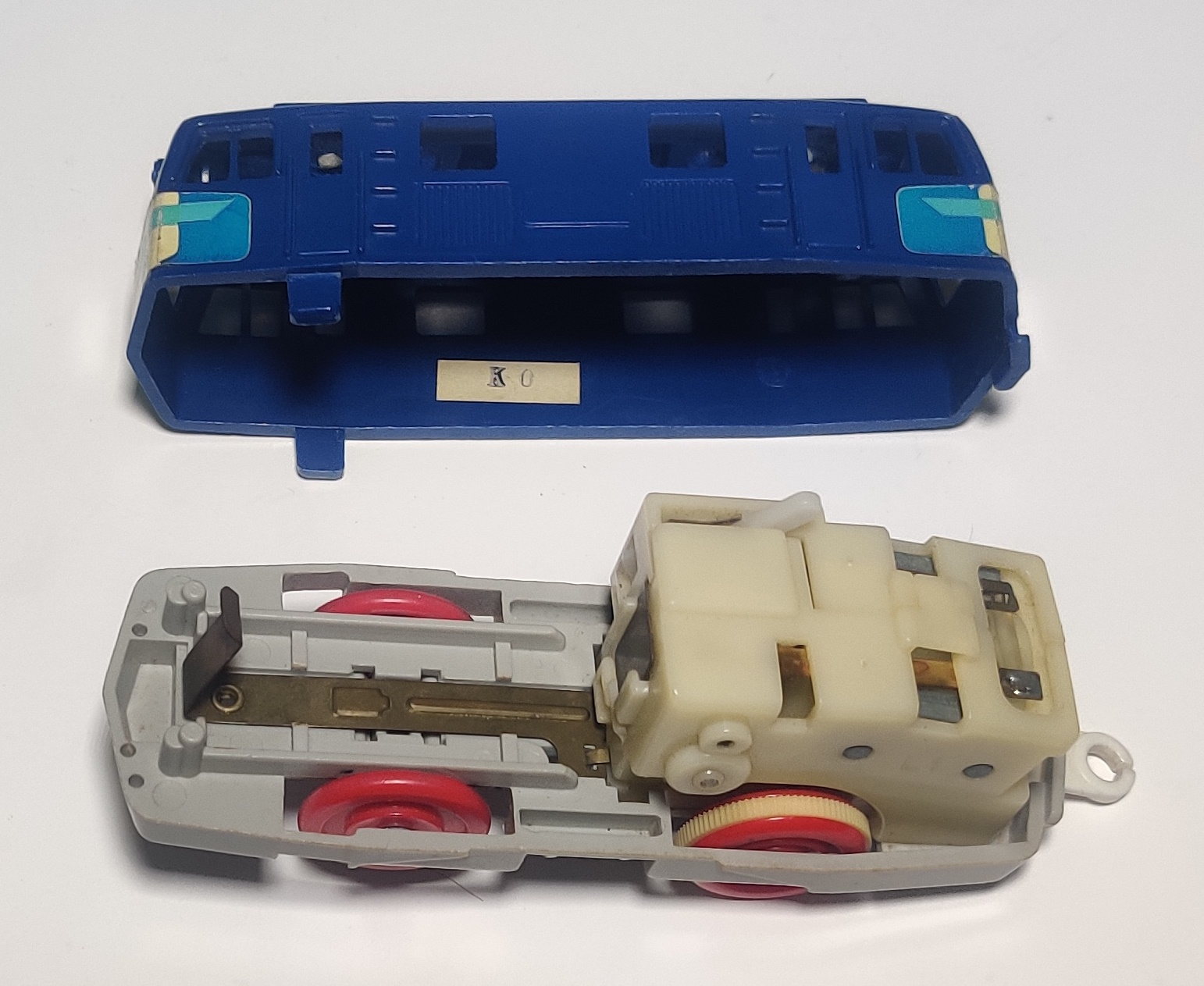
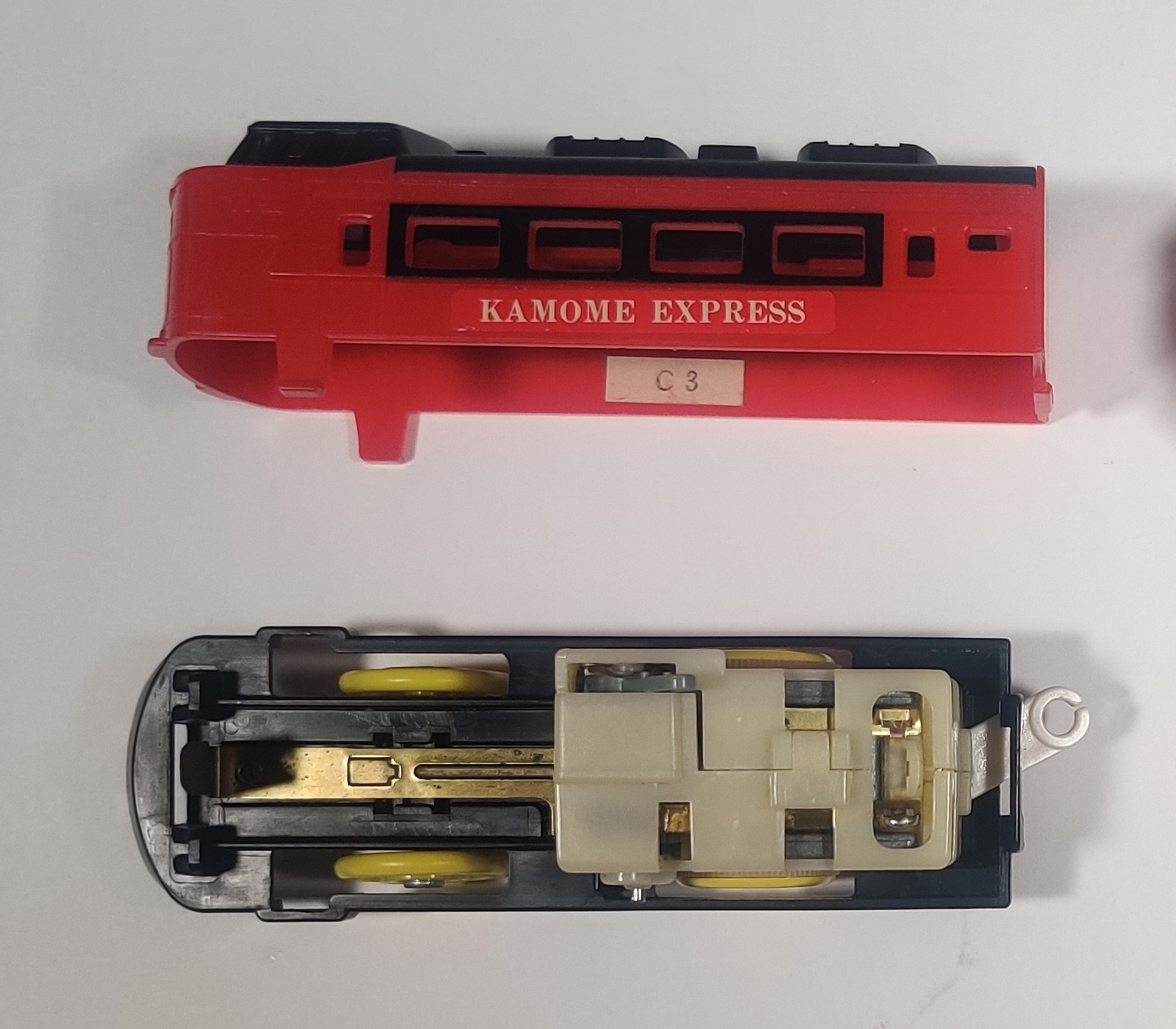
Early two-speed examples use black power switches and gears, changing to a bluish-grey also used on Japanese-produced single speed gearboxes until around 1990 when Japanese single-speed gearboxes began using white switches and gears.
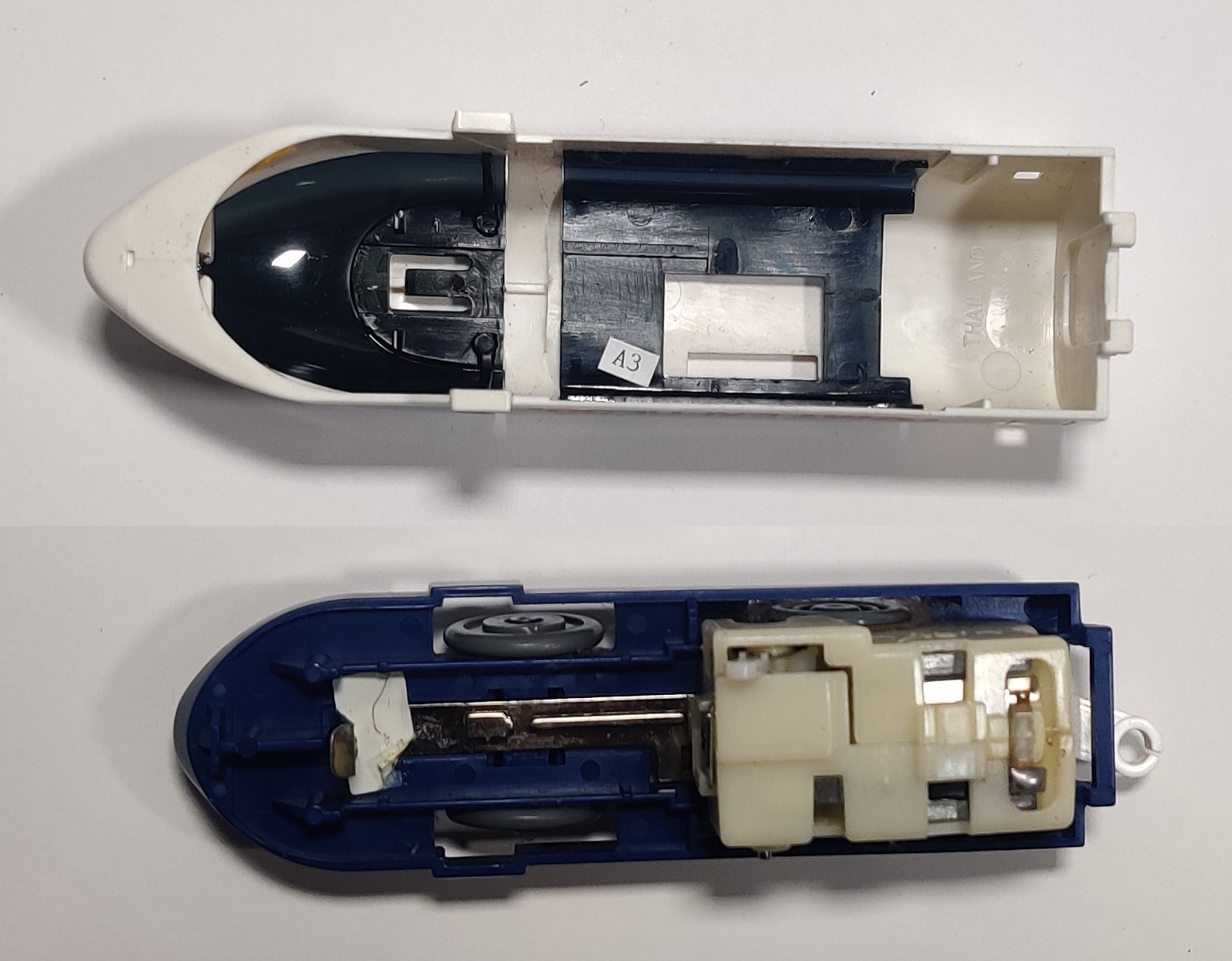
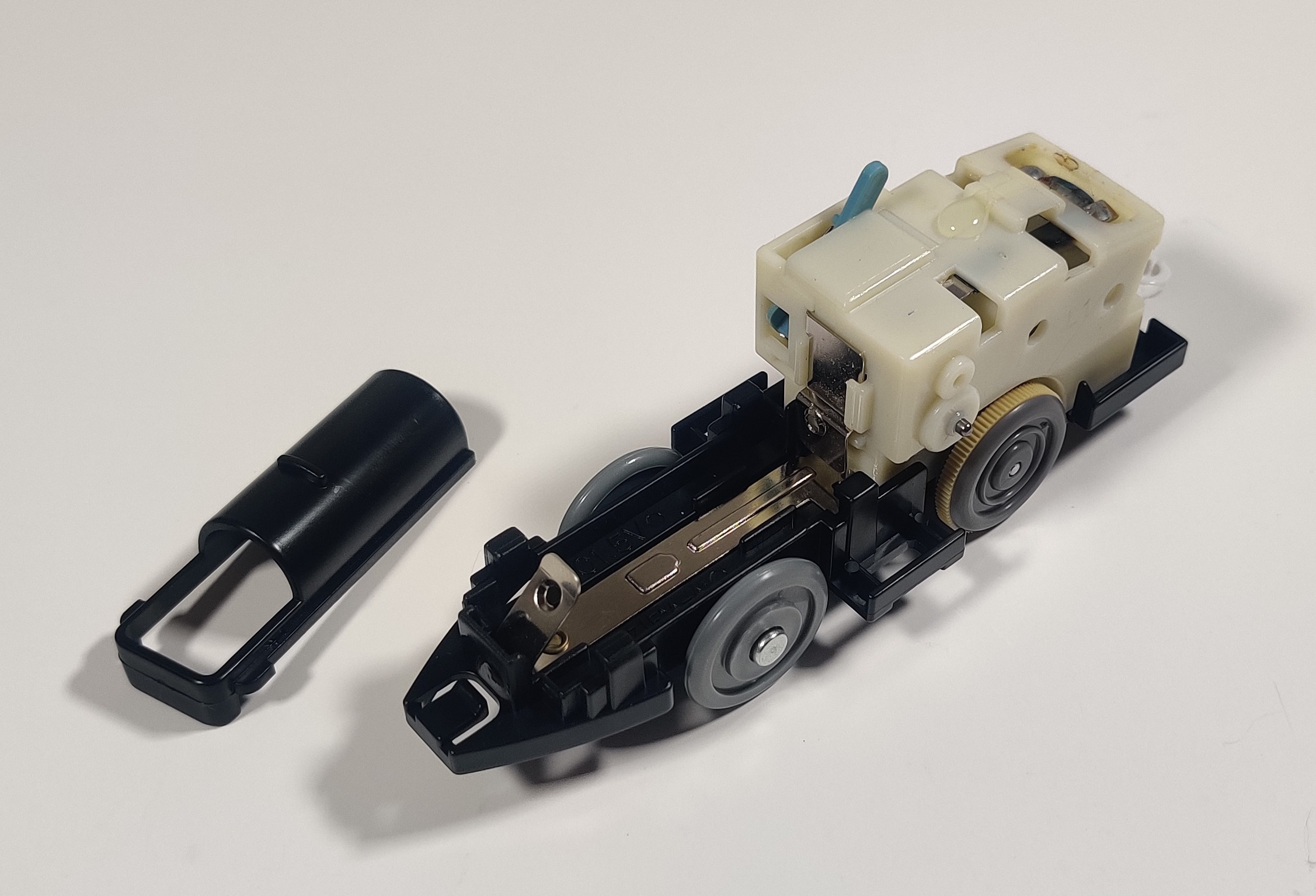
Early Thailand production used white power switches for the two speed and well as the single speed before changing the two-speed in the mid 1990s to use a light blue power switch and gears that seem prone to splitting.
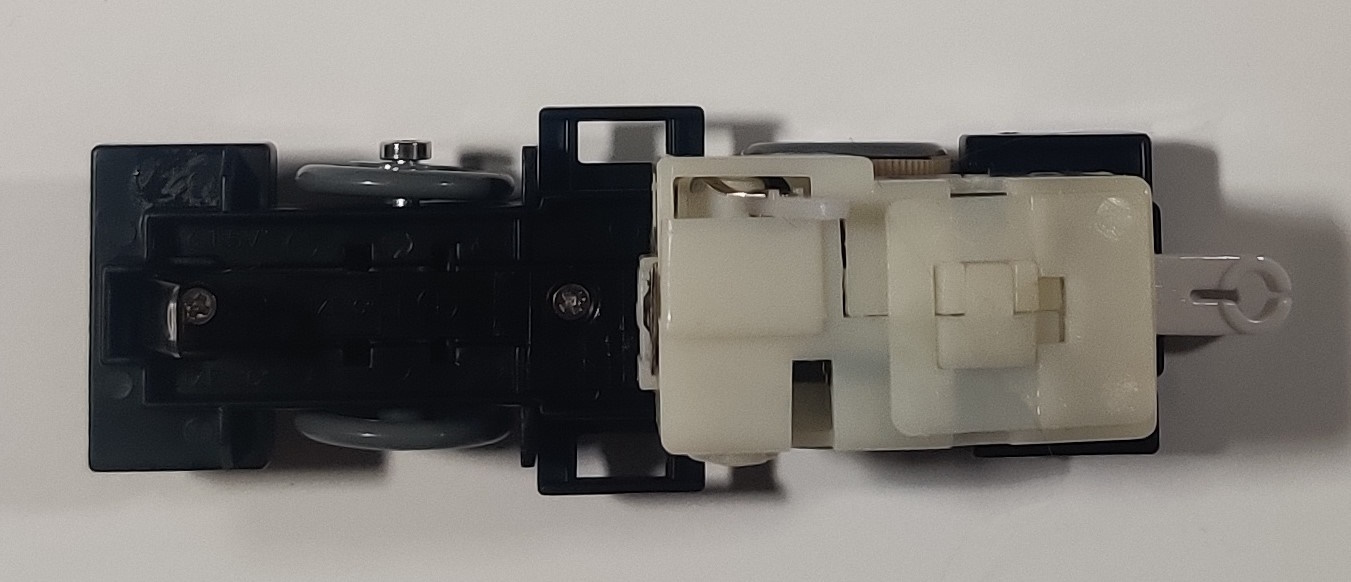
Later examples of the gearbox soldered both side of the motor in place and added plastic shielding to the upper portion of the gearbox. The gearbox is clipped into a molding feature of the chassis at the front and screwed in with two screws at the rear.
The "new" of "new power" gearbox comes from the changes between it and the "old power" friction drive gearboxes. It is certainly not the newest gearbox type and is in fact the oldest type that still sees any use, being the very first axle-drive gearbox.
Geartrain and repair

The new power gearbox transmission starts at the motor pinion on the motor output shaft. This is an eight tooth gear that fits on the 2mm output shaft of the motor and it meshes with a 22 tooth crown or contrate gear with 90 degree teeth to transmit the power to be perpendicular to the motor output shaft to save space in the gearbox. This is a tactic dating back to the very first Plarail gearbox. This forms a 8:22 or 4/11x gear reduction, slowing down but increasing the power of the motor. On the same 2mm shaft as the crown gear is a long eight tooth gear. The length of this gear allows the next shaft in the gearbox to be spring-loaded and actuated by the power switch, with the 20 tooth gear on the sliding shaft always in contact with the eight tooth gear for a 8:20 or 0.4x reduction. On the single speed version of the gearbox the 14 tooth gear also on the sliding shaft engages with the 20 tooth gear on the clutch when turned on for a 14:20 or 0.7x reduction, and on the two speed version the 14 tooth gear engages with the 20 tooth gear when turned to "ON" and the 20 tooth gear engages with the 14 tooth gear on the clutch essentially turning it into an idler and transmitting power from the 8 tooth gear before it to the 14 tooth gear for an 8:14 or 4/7x reduction. A small eight tooth gear is spring-loaded up against the larger gear with a wavy pattern at the interface to form a clutch that can be overcome when the wheels are stalled. This was likely to protect both the motor and a child who might catch their hair in the spinning wheels as it will begin clicking and slipping instead of continuing to run the output. The 8 tooth gear engages with the 24 tooth gear molded into its own plastic axle and another 8 tooth gear which drives the 12 tooth gear on the drive axle through an idler pinned to the opposite side of the gearbox casing for 1/3 and 2/3 reductions. In total the single speed and lower gear on the two-speed version come out to ~0.0226x the free speed of the motor (assuming 100% efficiency (LOL)) and the high speed comes out to ~0.0462x, theoretically double the slower speed (but with less than half the pulling power)
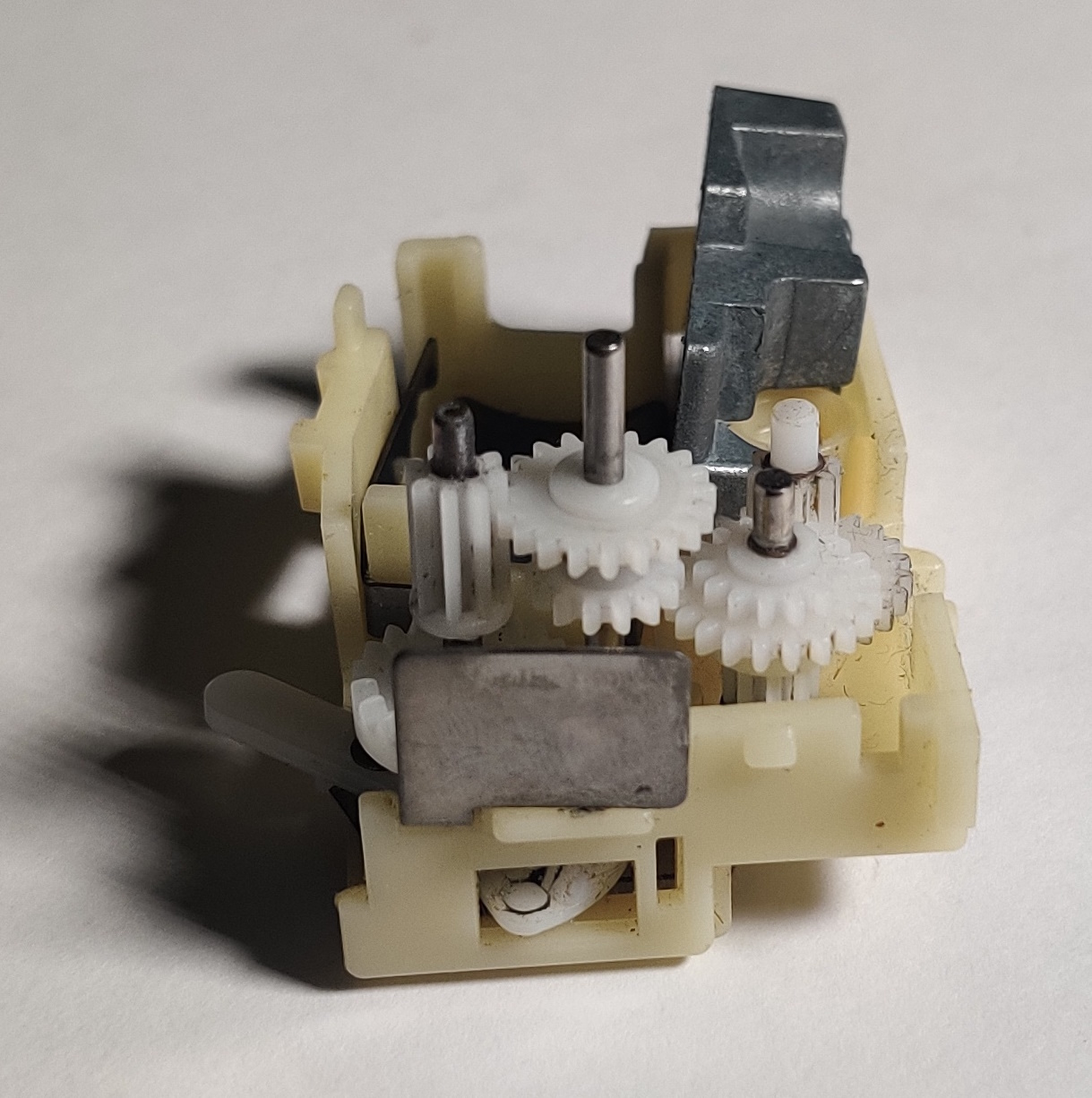
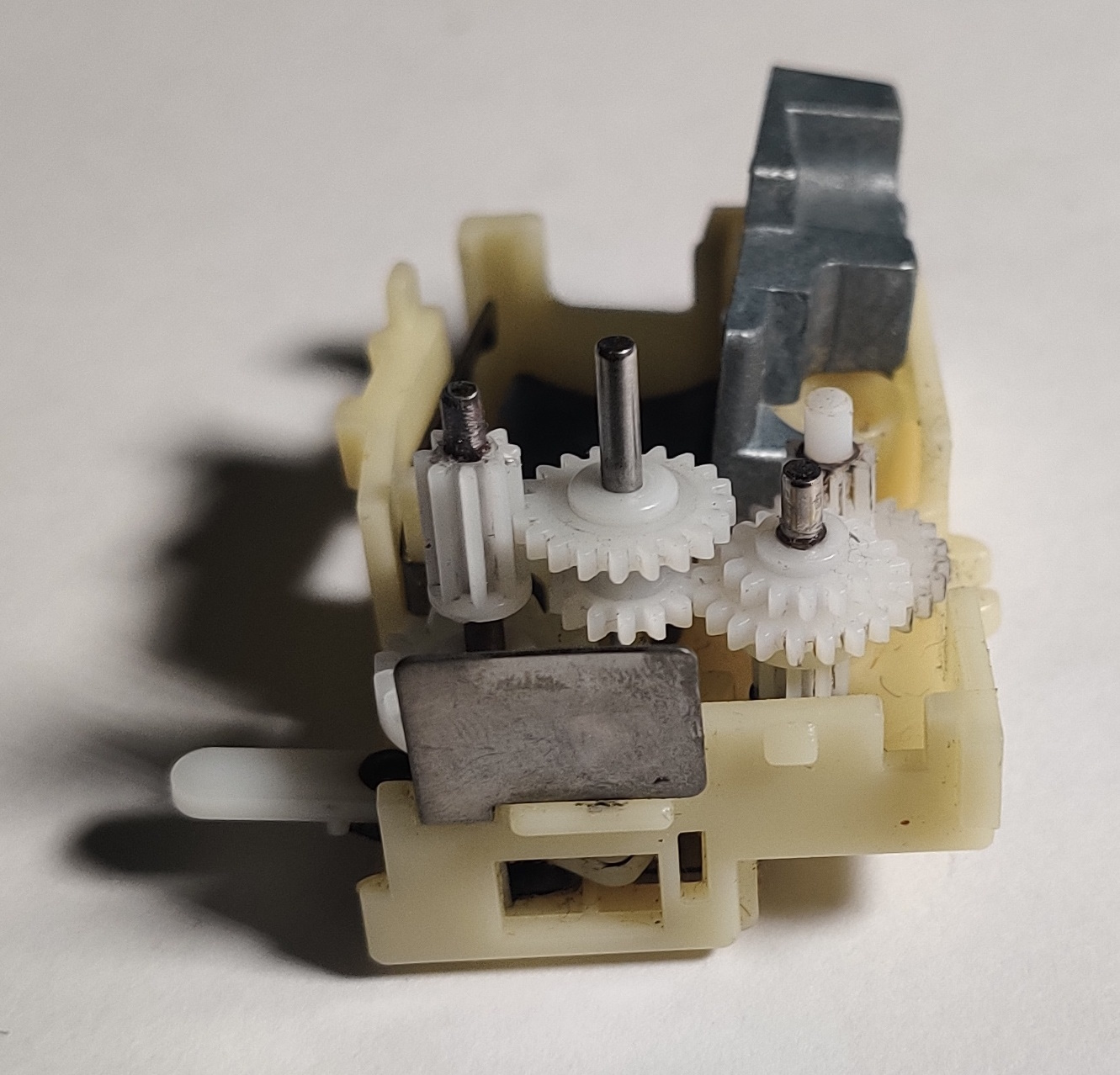
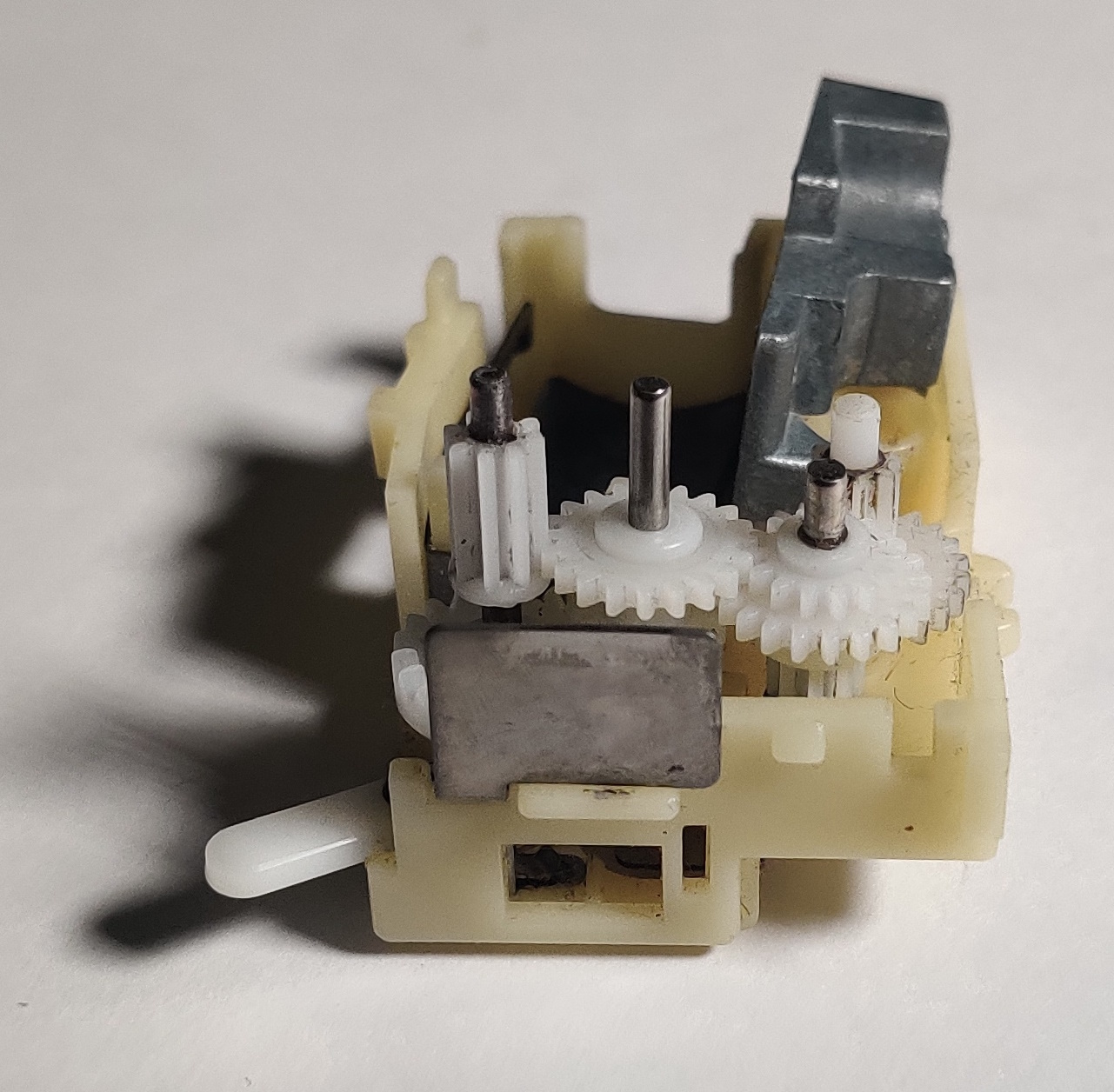
Here is the sliding shaft of the gearbox in a two-stage new power gearbox in the off (left), on (center), and high (right) positions. Normally, a spring sitting on the top of the sliding shaft pushes it away from the also-removed left half of the gearbox. When the gearbox is off, the spring pushes the shaft inwards and neither the 20 nor the 14 tooth gear on the sliding shaft engage with the next stage (although the 20 tooth gear is always engaging with the long eight tooth gear in the previous stage). When the gearbox is set into on, a wedge on the power switch slides away and allows the spring to push the shaft deeper and the lower 14 tooth gear engages with the 20 tooth gear in the next stage. When the gearbox is set to high the power switch allows the shaft to slide even more and the upper 20 tooth gear slides even further down the eight tooth gear to engage with the 14 tooth gear in the next stage, becoming an idler in the overall chain. The single speed gearbox does not include the 14 tooth gear molded into the 20 tooth gear in the next stage, and the power switch only pushes the lower 14 tooth gear on the sliding shaft into and out of the geartrain.
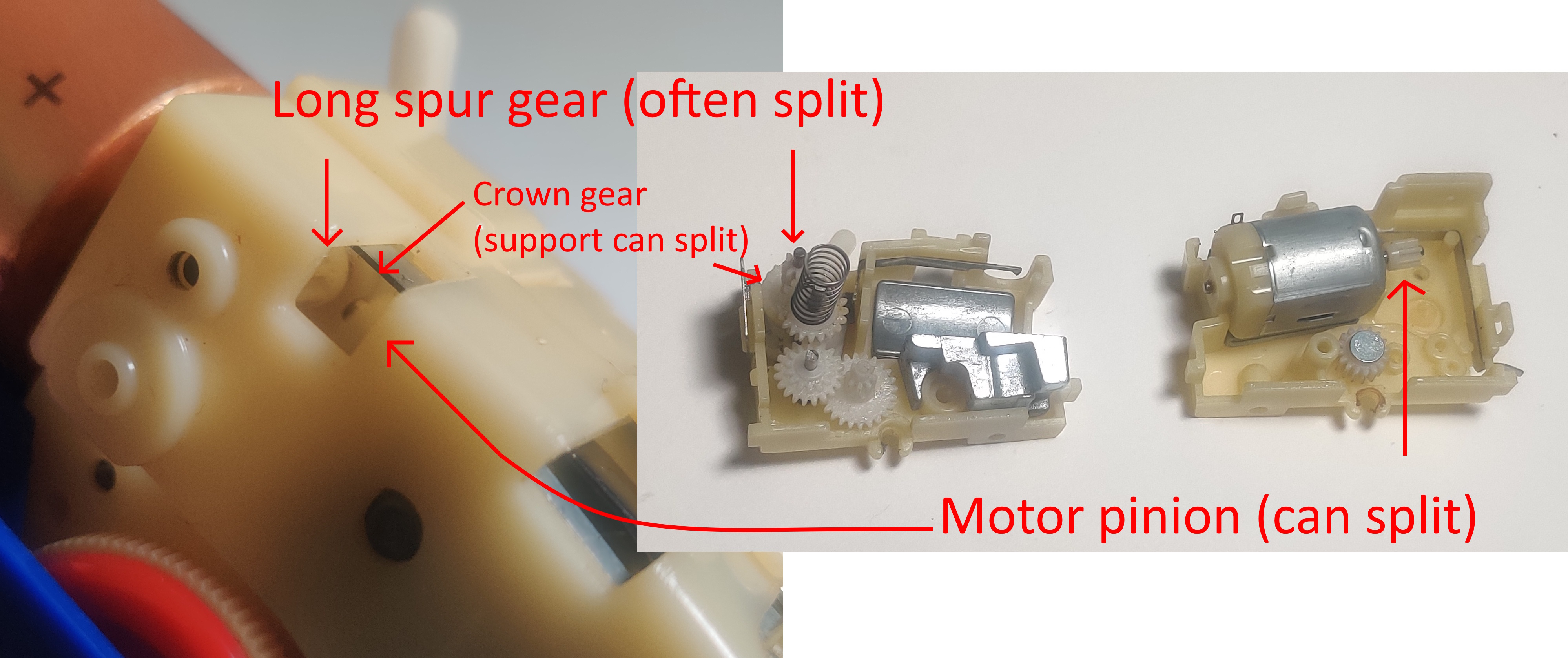
Some of the gears in the gearbox can be diagnosed without even opening the gearbox. The molding of the new power gearbox allows you to see most of the first two stages of the geartrain through a hole in the molding on the left side of the gearbox. if you turn the engine on and the wheels have no torque (I.E. you can hold the wheels still with your fingers easily while the motor is switched on and you can still hear the motor turning) it is likely that one of the smaller gears in the first two stages has split and is spinning on its shaft. The motor pinion and first two shafts in the new power gearbox are the same between one and two speed versions. Once you know which gears need to be replaced, see the notes below about disassembly of some different variations of the new power gearbox.
Most likely, the long gear that transmits power to the shifting stage of the gearbox is split. I see this on nearly every older (pre-2000 or so) Thailand-made new power gearbox that I come across, single and two-speed. If you turn the motor on and can see the gear mounted directly on the motor's output shaft spinning as well as the "crown" gear with teeth mounted at 90 degrees spinning but the longer spur gear on the same shaft as the crown gear is not spinning, it is most likely split.
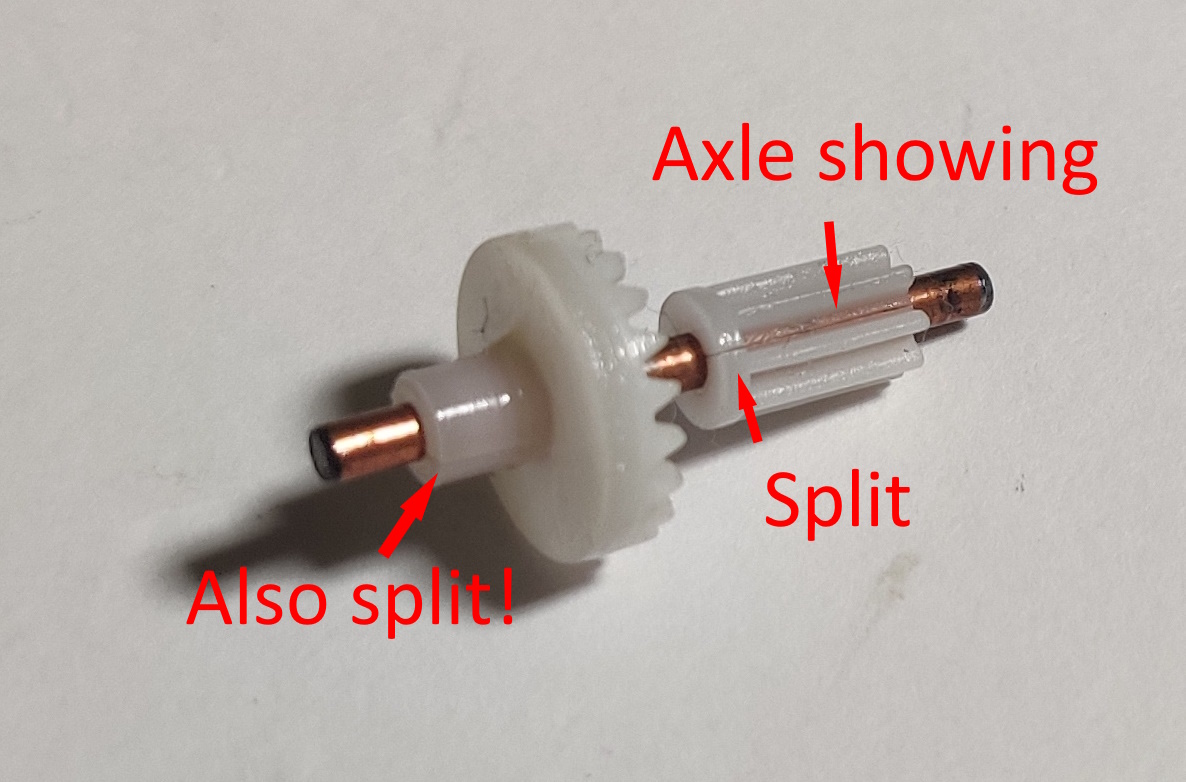
Sometimes you can get away with regluing this gear onto the axle if the split is not too large. The better long-term solution is to replace this gear with two commonly available eight tooth gears with 2mm shaft diameters. Two shorter gears are stacked together to make up the height of the taller original gear. These can be purchased as hobby or toy car gearbox replacement parts. Slide the old gear off the shaft and fit two of the new shorter gears in its place, lining up the teeth on both. I usually find that brand new gears are a good enough friction fit to not need additional adhesive or another setting mechanism. I actually tried 3D printing these longer gears but they are below the effective limit of my Creality Ender 3 Pro. I suspect you could potentially have better results with a resin or even an FDM printer that could handle more precise printing, but eight tooth gears with a 2mm shaft hole are easy enough to find. The larger contrate or "crown" gear with perpendicular teeth that transmits power 90 degrees will also sometimes split on the protruding section holding it onto the shaft. The success rate of supergluing this gear in place without causing the gearbox to get "rougher" is generally decent because the split does not usually extend to the actual teeth or face of the gear, but your mileage may vary.
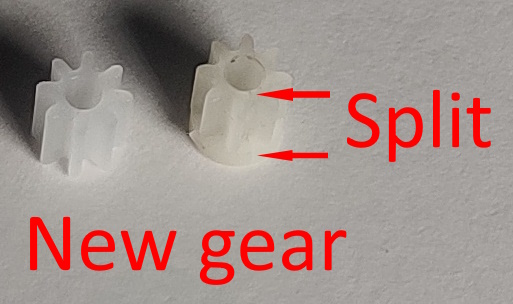
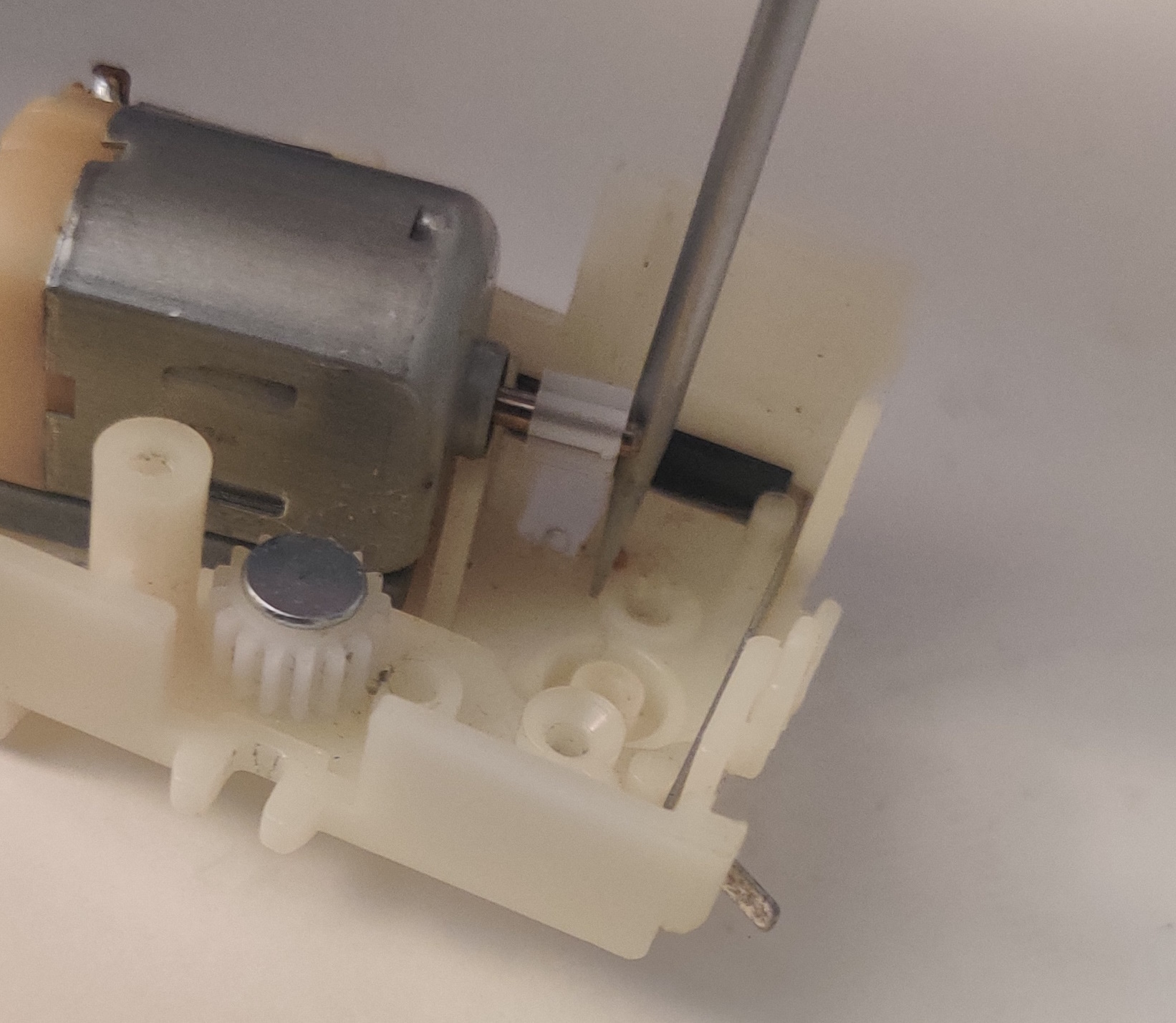
Another very similar gear that can split is the eight tooth pinion gear on the output shaft of the motor. If none of the gears are visibly spinning but you can still hear (or feel, using the small nub of the shaft sticking out of the back of the gearbox) the motor running, this gear is probably split. After disassembling the gearbox it should be relatively easy to slide the gear forward and off the motor and the new gear can usually be pushed onto the output shaft without fully removing the motor with the aid of part of the plastic molding to hold the first gearbox shaft.
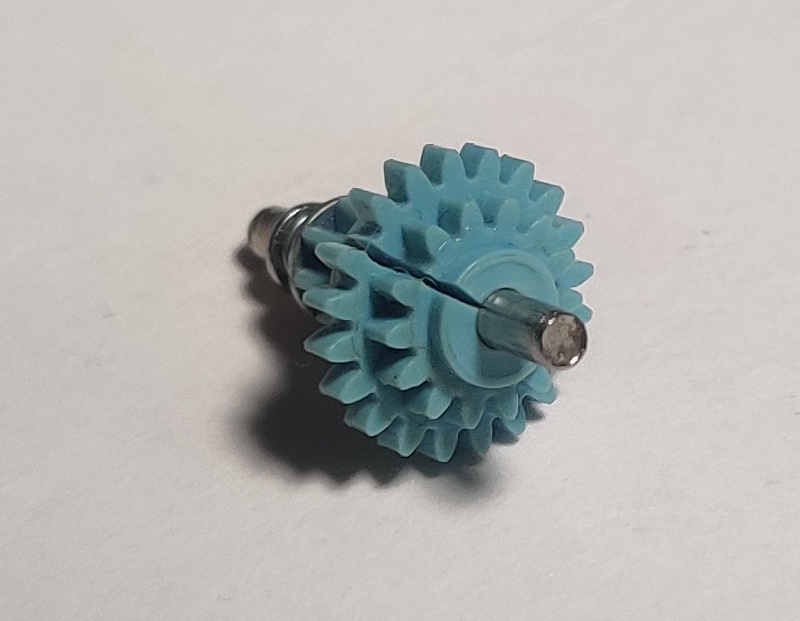
If all these gears appear to be spinning and you can hear the clicking of the clutch or the clutch is slipping at the slightest force the 20 tooth (single speed) or 20 and 14 tooth (two speed) gears on the upper portion of the clutch may be split. I do not currently have a good replacement for this gear and unfortunately when I have seen it split it splits fairly catastrophically, forming much too large a crack to try to glue the gear in place. Your best bet is to salvage a gear from another junk gearbox.
The last two gears in the gearbox will probably not give you any problems. The idler pinned into the left side of the gearbox spins freely on its shaft so it will most likely not contract to the point that it splits around its axle. The second to last gear is molded into its own plastic axle so there is no axle for it to contract and split around.
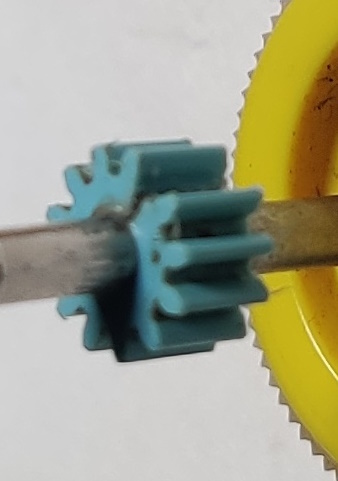
The gear on the main driving axle also splits fairly commonly. This is a 12 tooth gear on a 2.5mm shaft. Take care when aligning the new gear as having it too far over to either side will cause the wheels to rub against the chassis and/or gearbox.
Gearbox disassembly
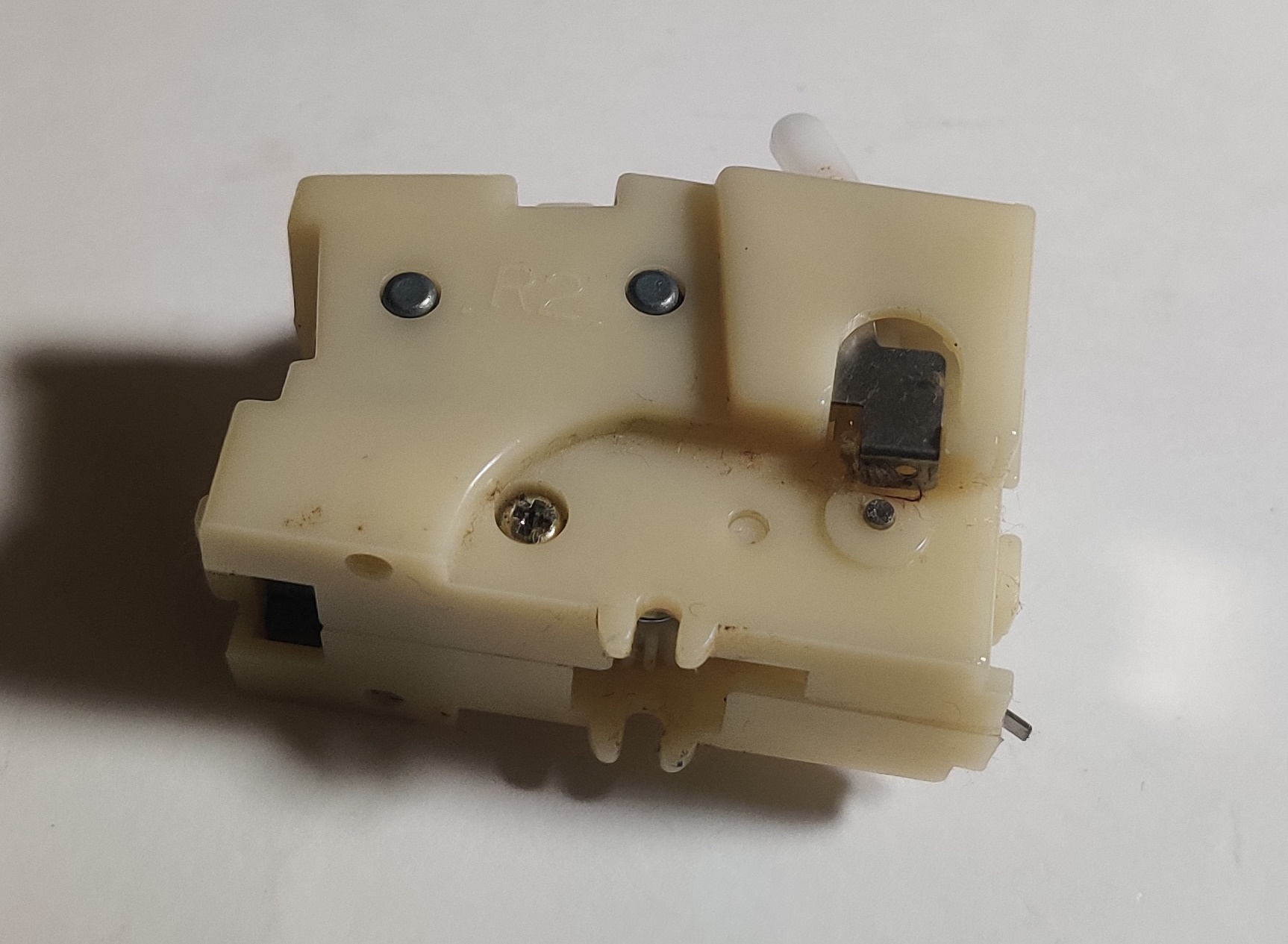
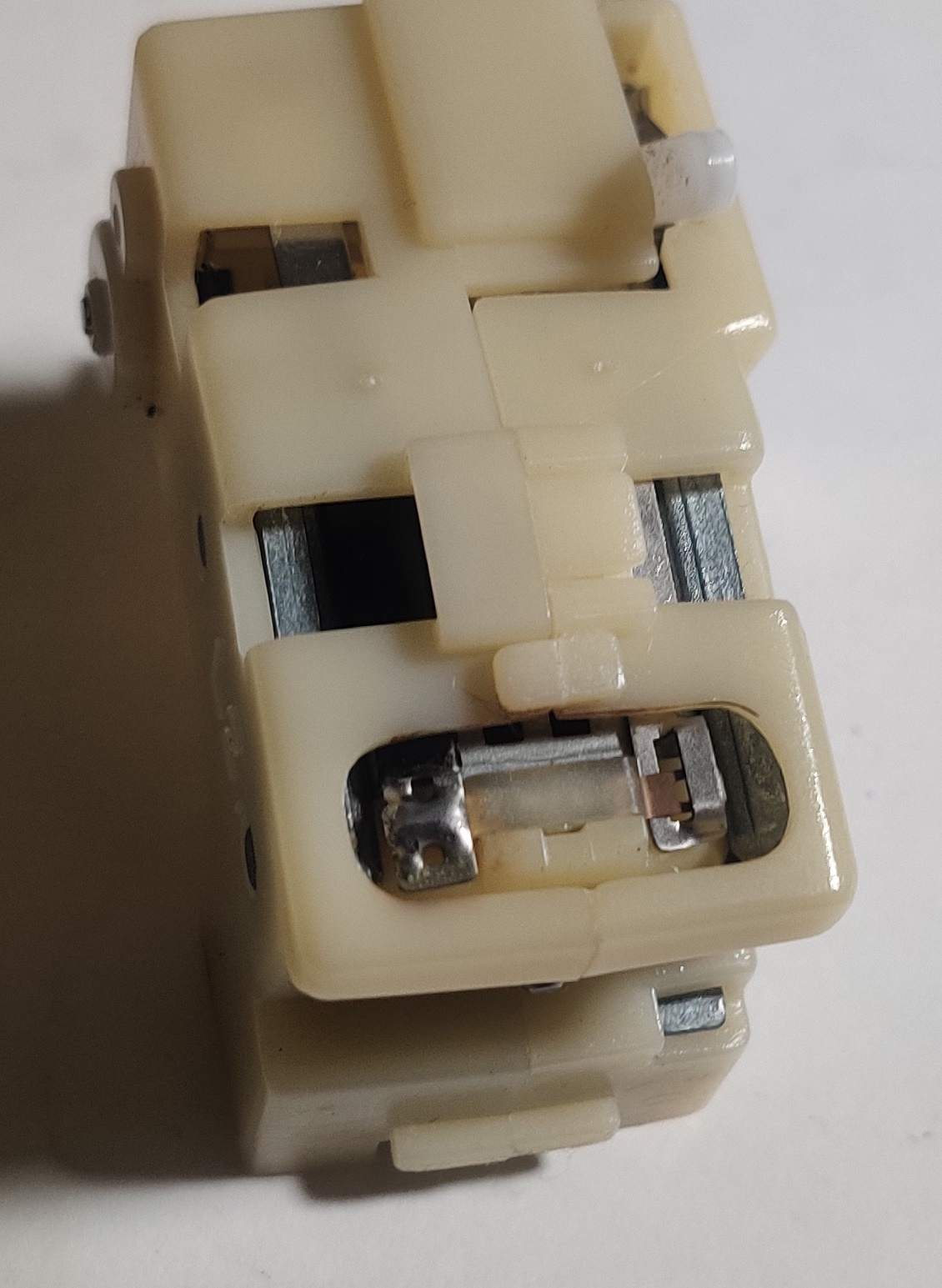
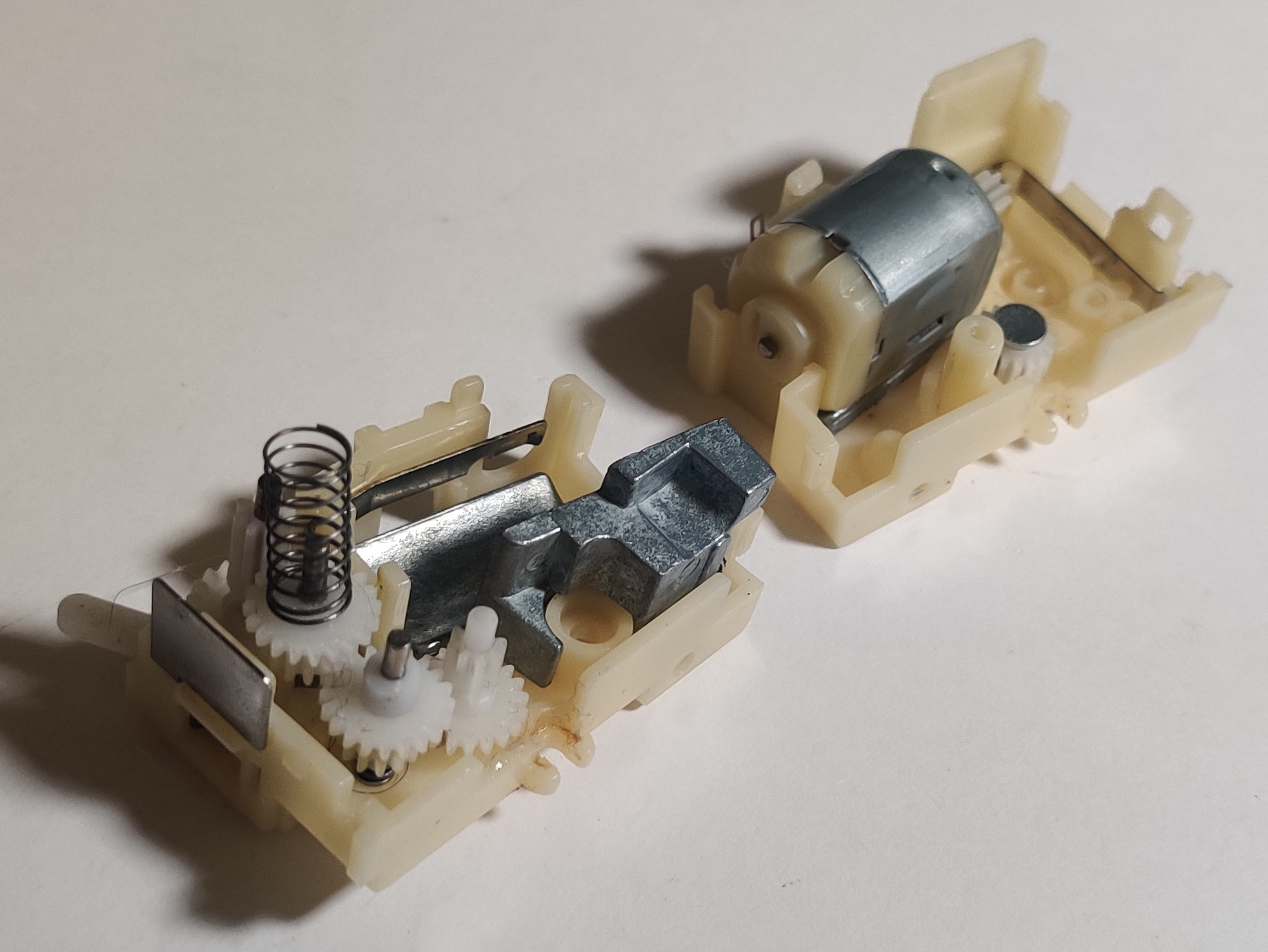
Earlier examples of the new power gearbox are easier to disassemble, with just one screw hidden behind the right wheel and two plastic clips holding the casing together. Earlier examples have the motor soldered to the contact strip in the left side of the housing and the right motor tab simply tucked into the right contact strip. This allows the gearbox to easily split in two, with the motor and a single idler in the left side and the rest of the gears and power switch in the right side.
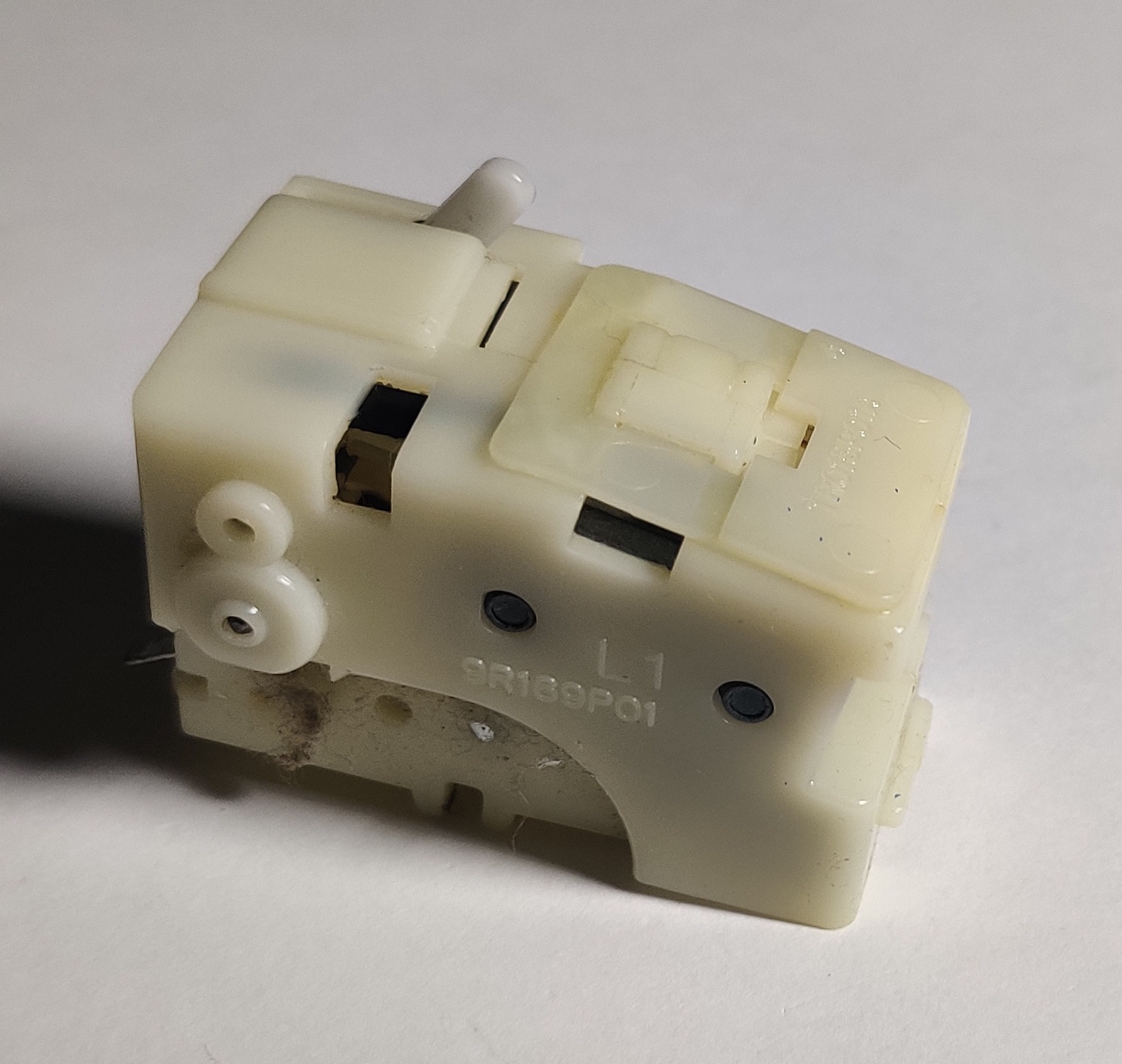
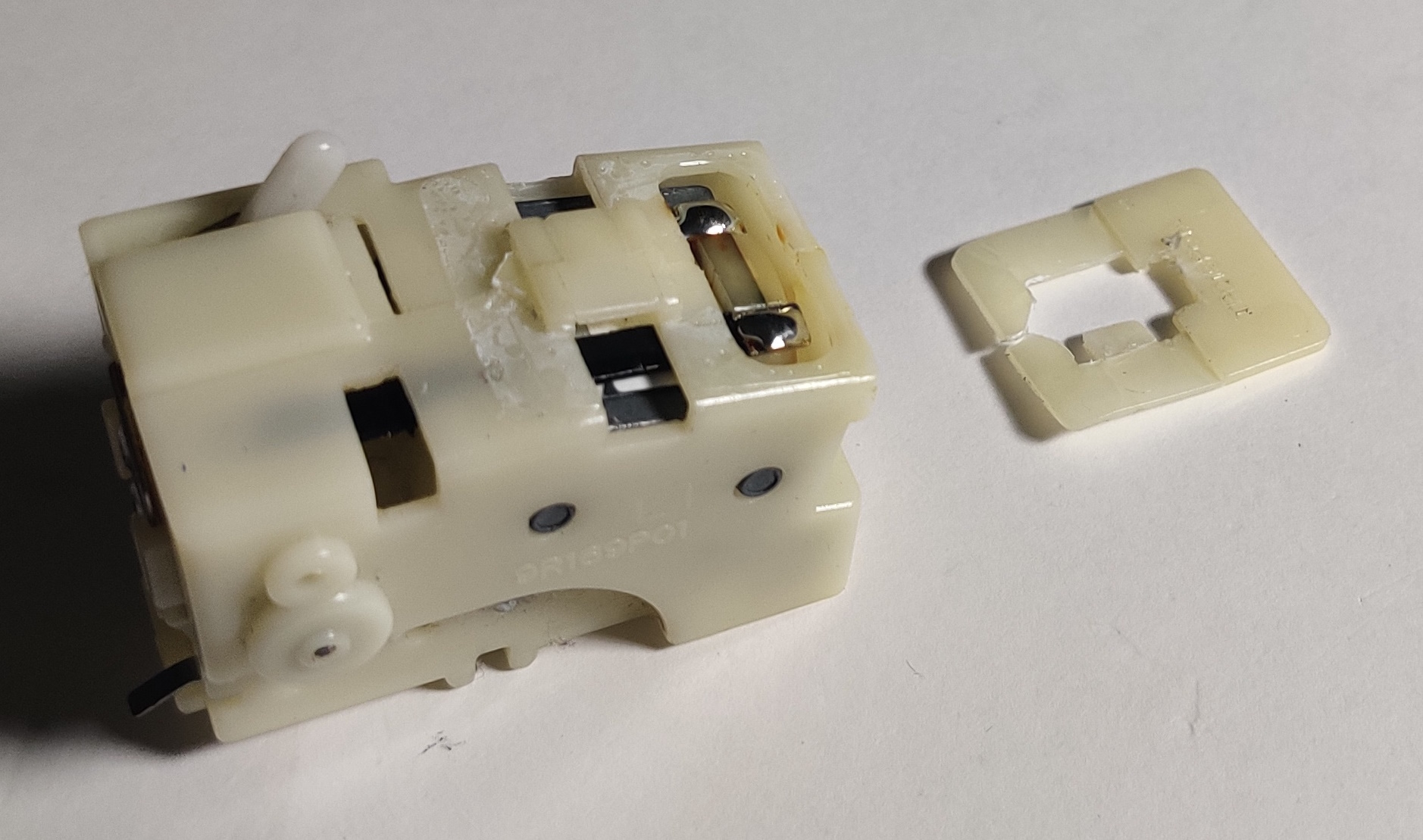
Later examples of the new power gearbox have this plastic clip that slots under the top casing clip that covers some of the exposed contact strip and the motor terminals. This was seemingly added as a safety feature or to prevent children from messing with the somewhat fragile motor connections. Often these gearboxes also have both motor terminals soldered to the contact strips. I would recommend popping off or otherwise removing the clip (I usually try to do this as nondestructively as possible, but as pictured sometimes it is easier to split areas with high amounts of glue than to pop them off) and then removing the screw and pulling the gearbox apart while heating the right motor contact with a soldering iron so it can be removed like the older style of gearbox where this contact was not soldered. At this point the gearbox can be split apart like the older style.
Reassembling the gearbox is a matter of making sure all the gears and weights are in the correct location and then making sure the shafts line up with their mating holes. The screw post and the weight that fits around it help to locate the bottom rear of the gearbox together. Make sure the spring on the sliding shaft is reinstalled. The cutout in the molding under where this spring locates can be convenient to poke at the spring through, and shafts can similarly be pushed into place with a small screw driver from any of the various holes in the casing.